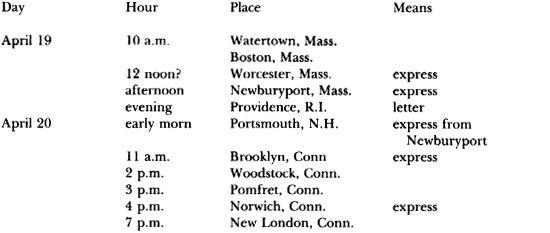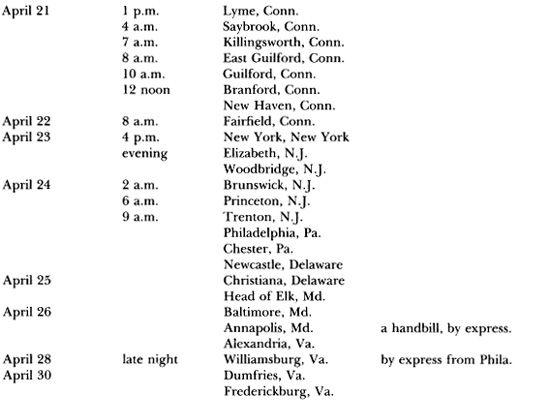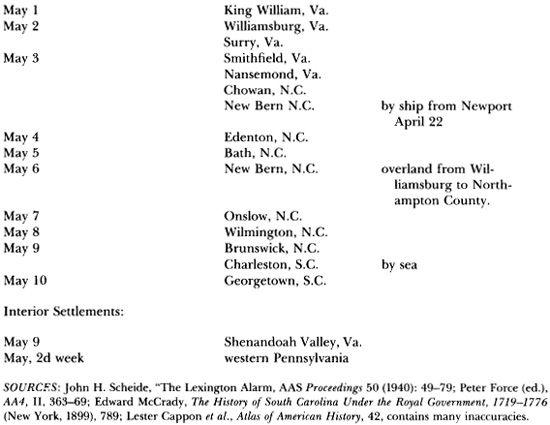Paul Revere's Ride (57 page)
Read Paul Revere's Ride Online
Authors: David Hackett Fischer
Tags: #General, #Biography & Autobiography, #History, #United States, #Historical, #Revolutionary Period (1775-1800), #Art, #Painting, #Techniques

10th Foot:
Of the light infantry, “A sergeant of the company came to me and inform’d me he had but 12 men and could not find any other officer [Kelly, Parsons and Lister all were casualties].” (Lister). For the entire regiment, Gage reported 1 killed, 17 wounded, 1 missing.
18th Foot:
Of the grenadier company, the only unit engaged, 2 killed, 4 wounded (Gretton,
Regimental History).
Gage reported 1 killed 4 wounded,
1
missing.
23rd Foot:
“our regt had 5 killed and 31 wounded.” (Mackenzie; aa4, 440); Gage reported 4 killed, 27 wounded and 6 missing.
38th Foot:
Gage reported 4 killed, 12 wounded.
43rd Foot:
Gage reported 4 killed, 6 wounded, 2 missing.
47th Foot:
Gage reported 5 killed, 23 wounded.
52nd Foot:
Gage reported 3 killed, 2 wounded, 1 missing.
59th Foot:
Gage reported 3 killed, 3 wounded.
British Marines:
Gage reported 27 killed, 40 wounded, 7 missing.
APPENDIX R
 Casualties among British Officers on the Concord Mission, April 19 to June 17, 1775.
Casualties among British Officers on the Concord Mission, April 19 to June 17, 1775.
Commanders
Lt. Col. Francis Smith,
10th Foot, wounded in retreat from Concord
Major John Pitcairn,
British Marines; injured in retreat from Concord, mortally wounded at Bunker Hill
4th Foot, Light Infantry Company
Capt. Nesbit Balfour,
wounded at Bunker Hill
Lt. Edward Gould,
wounded and captured on the Concord expedition
Lt. John Barker
4th Foot, Grenadier Company
Captain John West,
wounded at Bunker Hill
Lt. Edward Barron,
wounded at Bunker Hill
Lt. Leonard Brown,
wounded at Bunker Hill
5th Foot, Light Infantry Company
Capt. John Battier
Lt. Thomas Hawkshaw,
wounded on Concord expedition
Lt. Thomas Cox,
wounded on Concord expedition
5th Foot, Grenadier Company
Capt. George Harris,
wounded at Bunker Hill
Lt. Thomas Baker,
wounded on Concord Expedition
10th Foot, Light Infantry
Capt. Lawrence Parsons,
wounded at Concord, and again at Bunker Hill
Lt. Waldron Kelly,
wounded on Concord expedition
Ensign Jeremy Lister,
volunteer, wounded on Concord expedition
10th Foot, Grenadier Company
Capt. Edward Fitzgerald,
wounded at Bunker Hill
Lt. James Pettigrew,
wounded at Bunker Hill
Lt. Thomas Verner,
died of wounds at Bunker Hill
18th Foot, Grenadier Company
Capt.
John Shee
Lt. George Bruere
Lt. William Blackwood
23rd Foot, Light Infantry Company
Capt. Robert Donkin
Lt. Thomas Walsh
Lt. Onslow Beckwith,
wounded at Bunker Hill
23rd Foot Grenadier Company
Capt. William Blakeney,
wounded at Bunker Hill
Lt. Thomas Gibbings
Lt. John Lenthall,
wounded at Bunker Hill
38th Foot, Light Infantry Company
Capt. St. Lawrence Boyd,
wounded at Bunker Hill
Lt. William Wade
Lt. Francis Johnstone
38th Foot, Grenadier Company
Capt. William Crosbie
Lt. John Howe
Lt. Robert Christie,
wounded at Bunker Hill
43rd Foot, Light Infantry Company
Capt. Walter S. Laurie
Lt. Edward Hull,
mortally wounded on the Concord Expedition
Lt. Alexander Robertson,
wounded at Bunker Hill
43rd Foot, Grenadier Company
Capt. John Hatfield
Lt. Charles McLean
Lt. William Gubbins
47th Foot, Light Infantry Company
Capt. Thomas Henry Craig,
wounded at Bunker hill
Lt. John McKinnon
Lt. Thomas Storey
47th Foot, Grenadier Company
Capt. Richard England,
wounded at Bunker Hill
Lt. Christ. Hilliard,
died of wounds at Bunker Hill
Lt. Pook England,
wounded at Bunker Hill
52nd Foot, Light Infantry Company
Capt. William Browne
Lt. George Hamilton
Lt. Eward Collier
52nd Foot, Grenadier Company
Capt. William Davison,
killed at Bunker Hill
Lt. John Thompson,
wounded at Bunker Hill
Lt. William Gordon
59th Foot, Light Infantry Company
Capt. Narcissus Huson
Lt. Ambrose Simpson
Lt. George Cumine
59th Foot, Grenadier Company
Capt. George Gray
Lt. Melton Woodward
Lt. Andrew Despard
British Marines, Light Infantry Company
Capt William Souter,
wounded on retreat from Concord
Lt. William Pitcairn
Lt. Philip Howe
British Marines, Grenadier Company
Capt Thomas Averne,
wounded at Bunker Hill
Lt. William Finney,
killed at Bunker Hill
Lt. George Vevers
Advance Patrol, Volunteers and Officers on Special Assignments
Major Edward Mitchell,
5th Foot commanding
Capt. Charles Cochrane,
4th Foot
Capt. Charles Lumm,
38th Foot
Lt. William Grant,
Royal Artillery
Lt. F. P. Thorne,
4th Foot
Lt. William Sutherland,
38th Foot, wounded on Concord expedition
Lt. Jesse Adair,
British Marines
Lt. Hamilton,
64th Foot, captured on Concord expedition
Surgeon’s Mate Simms, 43rd Foot
SOURCE: Muster Rolls and Pay Lists, WO12, PRO
APPENDIX S
 Spread of the News of the First Shots at Lexington
Spread of the News of the First Shots at Lexington



 Myths After the Midnight Ride
Myths After the Midnight Ride
Seldom has fact supported legend, seldom has nature imitated art so successfully.
—Edmund S. Morgan
Even as the event was still happening, the legend began to grow. Long before Paul Revere reached home again, rumors of the midnight ride began to fly across the countryside. Returning British soldiers reported their encounter with “the noted Paul Revere” on the Concord Road. A newspaper in the city of New York informed its readers that Paul Revere was “missing and supposed to be waylaid and slain.”
1
In Boston, the story of the signals from the Old North Church made too good a story for Whig leaders to keep secret very long. Within days, a Tory refugee named Ann Hulton wrote to an English friend, “The people in the country … had a signal, it is supposed, by a light from one of the steeples in town, upon the troops embarking.”
2
By early June, the first report of Paul Revere’s ride appeared in print. Its author was William Gordon, Roxbury’s English-born Congregationalist minister, who appointed himself the first historian of the American Revolution. After the battle, Gordon rode to Concord and interviewed many participants, including Paul Revere himself. In the first week of June, he published an account of the battle which mentioned Revere by name, and briefly described the midnight ride, the capture, the rescue of John Hancock’s trunk, and Revere’s presence at the battle of Lexington. Gordon’s essay was very short, but remarkably full and accurate. Yet even as he wrote, the first of many myths was beginning to take form around the subject. Its inventors were the participants themselves.
3
 Participant Historians: The Myth of Injured Innocence
Participant Historians: The Myth of Injured Innocence
